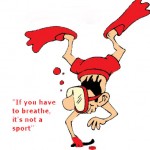Welcome to our new home…
 READY GO
READY GO
Separate teams line up on either end of the playing surface. Wearing a mask, fins and snorkel, while carrying a stick, each player anticipates the start. The chief referee makes a motion and then shouts: “Ready Go!” Muscles twitch as the race begins to the centre of the playing area. Frothing water is sent spraying in all directions. Players disappear; the water calms. Chaos returns in a split second. This time, the spray and splash is followed by heavy and laboured breathing. Players’ dive again bent on advancing a puck-sized disk towards the opposing team’s end. Like schooling or feeding fish, players travel in pods. They advance. They retreat and then they advance again. The choreography is intense yet subtle. A desperate scream echoes through a snorkel. The intensity increases for a moment. Calmness returns almost immediately as a pair of hands appear from the depths to signify a goal. Each pod of players returns to their side and within seconds the shout comes again “Ready Go!” The water is again transformed into a frothing mass of turbulent water.
Welcome to the fast-paced world of Underwater Hockey in Sault Ste. Marie, Ontario. Once a week, members of the Sault Tridents Underwater Club don their equipment and play fast and furious hockey as they hold their breath while trying to score.
In the mid 1970’s Underwater Hockey came to the Sault due to the creative endeavours of the late Dave Pier, former owner of Sault Scuba. It was not only a good way to stay in shape but it was fun. A number of local residents dove-in eager to play this unusual sport. Through practice and training they became the dominant Underwater Hockey team in Ontario. This is still true today.
Originally, the game was the brainchild of Alan Blake of Britain. In 1954, he called it “Octopush.” This game was designed to keep scuba divers fit during the non-diving season. It was relatively simple. Each player would wear a mask, fins, and snorkel and carry a short stick with a U-shaped end. The stick was use to push a metal puck, along the bottom of the pool, into an underwater net or trough. It was a glorified game of shuffleboard underwater. The bigger and heftier your players were the more chance the team could muscle its way down the pool and score on the opponents net.
Since that time the game has changed dramatically. The snorkelling equipment is more form-fitting. The stick has been redesigned so that instead of pushing, passes can be made to team members along with some amazing stick handling. The original brass puck has been replaced with a plastic-coated lead puck making the game much safer. The intensity and speed of Underwater Hockey is very similar to its ice-loving cousin. It is a game of speed, finesse, and timing.
Like ice hockey, there are only six players allowed on the playing surface at one time. Normally a team travels with 10 players. Four of these are substitutes that enter the water when the original 6 players get tired. Two 15-minute periods make up an underwater Hockey game. After 15 minutes, teams switch ends. Each game lasts about 30 minutes.
Unlike its cousin there are no off sides and Don Cherry doesn’t entertain the fans with commentary between periods.
Underwater Hockey is played throughout the world. Powerhouse teams are found in Australia, New Zealand, France, United Kingdom, and South Africa. Helen Lindfors, Chris Costello, Craig Zimmerman, Steve Kars, Jeff Park, all residents of Sault Ste. Marie, have played at the world level as members of Team Canada.
Interested in trying something different? Come out and take the plunge with the Soo Tridents. If you don’t have a mask, fins or snorkel, each club member has spare equipment. We will provide the training you need to enjoy this fun and fast-paced game. Hockey underwater is for everyone.